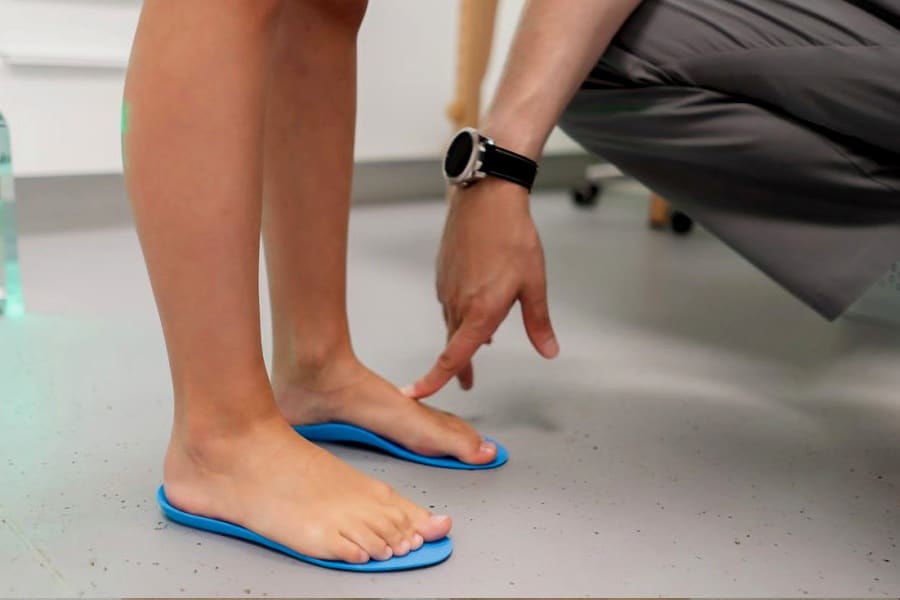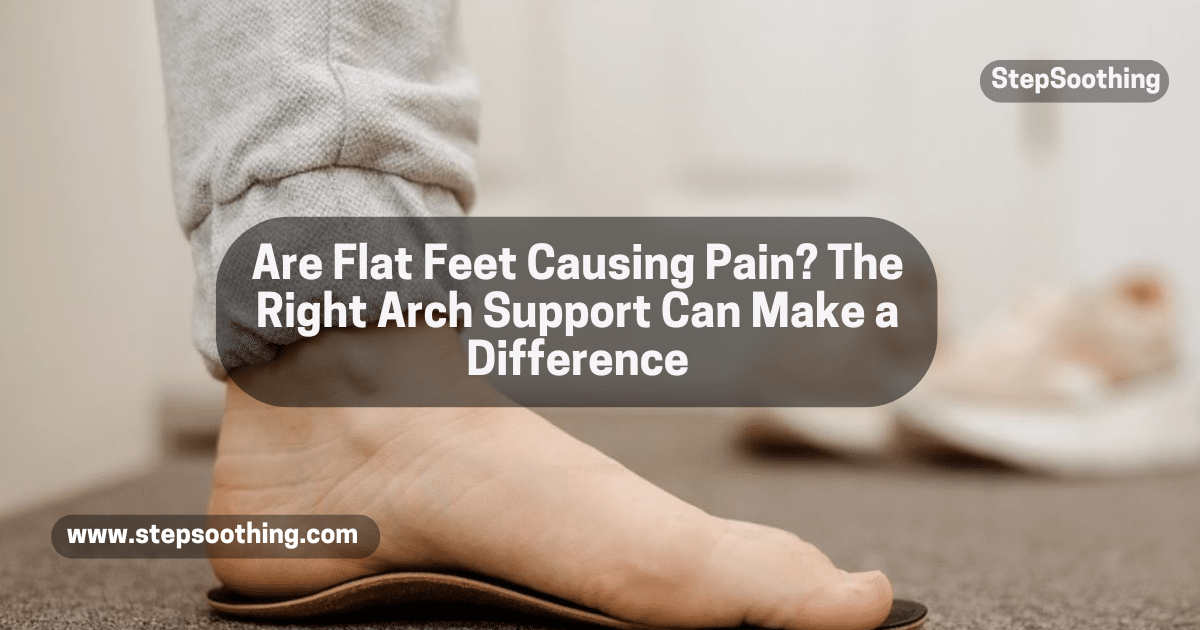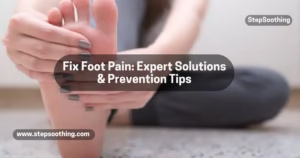Millions of people struggle with discomfort, fatigue, and misalignment due to flat feet, a condition where the arches collapse, causing the entire sole to touch the ground. Without proper arch support for flat feet, this condition can lead to overpronation, joint pain, and poor posture, increasing the risk of plantar fasciitis, shin splints, and knee discomfort.
The American Podiatric Medical Association (APMA) emphasizes that well-structured arch support for flat feet is essential for reducing strain, improving balance, and preventing long-term musculoskeletal issues. This guide explores the best types of arch supports, their benefits, and expert-backed recommendations to help you achieve optimal foot health and comfort.
Are Flat Feet Causing Pain? The Right Arch Support Can Make a Difference

Understanding Flat Feet and the Need for Arch Support
What Are Flat Feet?
Flat feet, or pes planus, occur when the natural arch of the foot collapses, causing the sole to rest entirely on the ground. This can be congenital or acquired over time due to factors such as aging, obesity, pregnancy, or extended periods of standing.
How Do Flat Feet Affect Posture and Movement?
Research from the Journal of Foot and Ankle Research suggests that flat feet contribute to abnormal foot mechanics, leading to:
- Overpronation, where the foot rolls inward excessively
- Increased stress on the ankles, knees, and lower back
- Higher risk of plantar fasciitis and Achilles tendonitis
For individuals struggling with foot pain due to flat feet, it’s essential to understand the causes, remedies, and prevention of foot pain to take proactive steps in managing discomfort.
Why Is Arch Support Essential?
Proper arch support distributes weight evenly, aligns the body, and minimizes strain on the feet. According to Dr. James Christina, DPM, Executive Director of the APMA, individuals with flat feet benefit from structured arch support as it prevents excessive foot motion and provides stability, reducing the risk of chronic pain.
Key Features to Look for in Arch Support
Selecting the right arch support requires careful consideration of several factors:
Firm vs. Soft Support
- Firm support is ideal for severe flat feet, offering structural stability.
- Soft support provides comfort and cushioning, making it suitable for mild cases.
Cushioning and Shock Absorption
According to a study published in The Foot Journal, cushioning materials such as gel, memory foam, and EVA foam can significantly reduce foot fatigue by absorbing impact forces.
For those considering using double insoles to enhance support, it’s crucial to weigh the benefits and potential drawbacks.
Stability and Motion Control
Arch supports with heel cups and medial posting help correct foot alignment and prevent overpronation, reducing strain on joints.
Custom vs. Over-the-Counter (OTC) Orthotics
- Custom orthotics, prescribed by podiatrists, provide personalized support for individuals with severe flat feet.
- OTC insoles, while cost-effective, are most beneficial for moderate flat feet cases.
Best Types of Arch Support for Flat Feet
Rigid and Semi-Rigid Orthotics
✅ Best for: Severe flat feet and overpronation
✅ Expert Insight: The American Academy of Orthopaedic Surgeons (AAOS) recommends rigid orthotics for patients requiring foot stabilization and biomechanical correction.
✅ Benefits:
- Provides maximum structural support
- Controls foot alignment and gait mechanics
- Reduces excessive strain on ligaments and tendons
If you’re unsure whether custom orthotics are necessary for you, learning about the signs and benefits can help guide your decision.
Cushioned Arch Supports
✅ Best for: Mild to moderate flat feet
✅ Expert Insight: A study from the National Library of Medicine suggests that cushioned arch supports help reduce plantar pressure and improve foot comfort.
✅ Benefits:
- Absorbs shock from walking and standing
- Enhances daily wear comfort
- Minimizes foot fatigue
Custom Orthotics
✅ Best for: Chronic pain or severe cases
✅ Expert Insight: Dr. Richard Blake, DPM, emphasizes that custom orthotics are designed to accommodate specific foot structures and provide long-term corrective benefits.
✅ Benefits:
- Provides tailored arch support
- Reduces strain on the plantar fascia
- Recommended for conditions like bunions and arthritis
Many people wonder whether a prescription is required for orthotics—understanding the difference between store-bought and custom options can make a significant impact on foot health.
Motion Control Insoles
✅ Best for: Athletes and active individuals
✅ Expert Insight: Research from the International Journal of Sports Medicine highlights that motion control insoles help stabilize foot movement, preventing excessive pronation during physical activities.
✅ Benefits:
- Improves foot alignment and shock absorption
- Ideal for runners, hikers, and individuals engaging in high-impact activities
Gel and Memory Foam Inserts
✅ Best for: Occasional foot discomfort and general use
✅ Expert Insight: The APMA states that gel-based insoles can enhance foot comfort, particularly for individuals standing for extended periods.
✅ Benefits:
- Provides soft, adaptive cushioning
- Ideal for casual shoes and work footwear
- Reduces pressure on sensitive areas
How to Choose the Right Arch Support
To find the most effective arch support, individuals should consider:
🦶 Foot Structure – Do the feet have complete arch collapse or partial flattening?
🏃 Activity Level – Is the person standing, walking, or engaging in sports?
🩺 Pain Severity – Are there signs of chronic foot, knee, or back pain?
When to See a Podiatrist
Experts at the Mayo Clinic recommend consulting a specialist if:
- Persistent foot pain or stiffness is experienced
- Arch collapse leads to difficulty in movement
- Standard arch supports fail to provide relief
Testing Arch Support Effectiveness
✅ A single-leg balance test can determine if the arch support provides sufficient stability.
✅ Walking on different surfaces can help assess comfort and pressure distribution.
People Also Asked
Can Arch Supports Correct Flat Feet?
While arch supports do not permanently alter foot structure, they significantly reduce discomfort and improve foot function by promoting proper alignment.
How Long Does It Take to Adjust to New Arch Supports?
Most individuals adapt within 1-2 weeks. Podiatrists recommend wearing new insoles gradually, increasing usage over time.
Are Store-Bought Insoles Effective for Flat Feet?
OTC insoles provide moderate support and can be effective for mild cases, but custom orthotics offer superior long-term benefits for severe flat feet.
Final Thoughts
Selecting the right arch support for flat feet can drastically enhance comfort, mobility, and overall foot health. Whether opting for rigid orthotics, cushioned insoles, or podiatrist-prescribed solutions, individuals should prioritize support that aligns with their foot structure and lifestyle needs.
Next Steps:
🔹 Try different insoles to assess comfort and support
🔹 Consult a podiatrist for custom orthotic recommendations
🔹 Invest in quality arch support to prevent long-term foot issues
By taking proactive steps toward foot health, individuals with flat feet can walk, run, and move comfortably, free from pain and discomfort.



